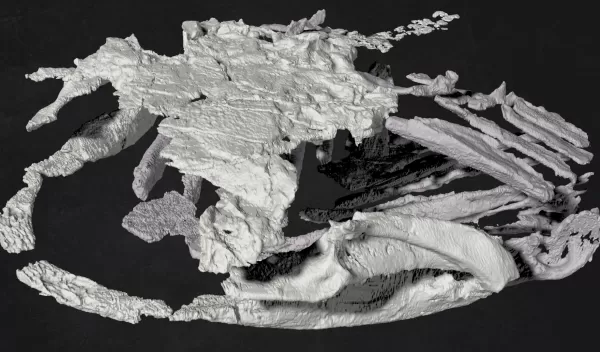
Ancient sharks likely more diverse than previously thought
Sharks have a reputation as ravenous hunters and apex predators, but new analysis of fossil records shows that some of the earliest sharks might have been filter feeders, taking in water through their mouths and catching food particles -- think less great white and more anchovy, another filter feeder.
This research, supported by the National Science Foundation (NSF), pushes the date for the last common ancestor between sharks and other types of jawed vertebrates back to 440 million years ago -- more than 17 million years older than the previous estimate -- and raises new questions about what life was like during a prehistoric period long shrouded in secrecy.
The specimen causing researchers to rethink the body plans of early sharks is known as Gladbachus. What did it look like?
"Probably pretty ugly," said University of Chicago biologist Michael I. Coates, lead author on a new paper published in Proceedings of the Royal Society B. At roughly 30 inches long, it would have lacked the typical elongated shark's profile, instead having a stubby snout and large, forward-facing eyes. Its body would have been fairly flat, like a combination of a shark and a catfish. And, significantly, its head would have made up about a third of its body length, with big gills. "That long gill basket is a clue that it was likely a filter feeder," Coates said.
Instead of lurking on the seafloor and ambushing prey, as many of its contemporaries did, Gladbachus may have been one of the first vertebrates to live in the water column -- the space between the ocean's surface and bottom -- where anchovies, sardines and herring make their home today.
That Gladbachus reconstruction model runs counter to some long-held notions in marine paleobiology. For a long time, sharks were considered "primitive," having evolved a body type long ago, with relatively little diversity in their early existence. But in the past decade, the scientific community has chipped away at that notion.
"Everything we're seeing now is saying that's not the case," Coates said. "Sharks were early specialists," possibly with a range of body types.
Part of the problem with studying ancient sharks is that, compared to other kinds of animals, they don't leave many clues behind. Sharks are cartilaginous, which means their skeletons are made of cartilage, not bones. While this allows them to be fast swimmers, it also means their skeletons often rot away instead of fossilizing. At most, they may leave rare "calcified cartilage," remains from parts of their skeletons that were packed with minerals.
"Often what's left is just teeth and a shower of scales," Coates said. "The problem in studying sharks is that they built this really lightweight, effective platform."
Scant remains
Teeth and scales, along with a small amount of calcified cartilage from the jaw and gill structure of a Gladbachus, were exactly what Coates and his team had to work with for this research. Their specimens dated back 385 million years and were collected in Germany which, like most of Europe, was covered by seawater during the ancient shark's lifetime.
The fossils revealed some unexpected features. "This fish has been confusing," Coates said. "We've only ever thought it to be a shark, but [it] didn't evolve the way we thought sharks did. It's almost like a facsimile or a copy of a shark, with some substitutions made."
While Gladbachus was definitely a shark, it had some curiously un-shark-like features. If you look at a piece of modern shark cartilage under a microscope, you see what look like tiles arranged in regular patterns. Gladbachus didn't have that tiling. And its scales were like the scales of placoderms, extinct fish that were often covered in thick, heavy armored plating. Probably the best-known placoderm is the massive predator Dunkleosteus.
That tells scientists that rather than the "primitive" evolutionary path, ancient sharks came from a period of evolutionary experimentation. Sharks developed as an evolutionary offshoot from bony fish -- non-armored species with skeletons made of bone, like modern fish. But rather than a complete split into a new family tree, Coates said, Gladbachus and its contemporaries were more like the tips of emerging shrubbery, with a whole range of body types -- probably including some that resembled placoderms.
"The earliest sharks might well have been armored," Coates said. "We just don't know how to recognize them yet."
Ancient seas
The findings also indicate that the last common ancestor between sharks and other types of jawed vertebrates must have existed much earlier than previously thought -- by more than 17 million years.
That common ancestor is the last organism that existed before sharks split off into their own family tree, moving away from other types of jawed vertebrates, which at the time included bony fish, but grew into a group that encompasses everything from salmon to humans. That means that the last ancestor that people and great white sharks had in common was swimming around the prehistoric ocean about 440 million years ago.
The time adjustment is significant from a scientific perspective, as it places the last common ancestor deeper into the Silurian period, which lasted from about 444 million years ago to 420 million years ago. Scientists often consider the geologic period that followed the Silurian, the Devonian, as the "age of fish." It was a time when aquatic organisms, including placoderms, sharks and bony fish, grew to dominate most of the planet's underwater environments, exploding in both population and species diversity.
But the new findings indicate that the Silurian could hold new treasures for biologists, if they can find evidence of the organisms that were living there.
"Another thing this area of research shows," Coates said, "is how poor the Silurian fossil record is."
But with more fossil discoveries and new analytic techniques, that could change, leading to new ways for envisioning ancient seas, he said.
